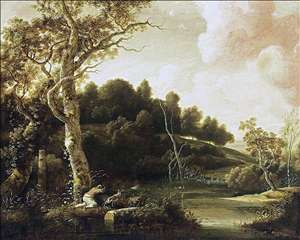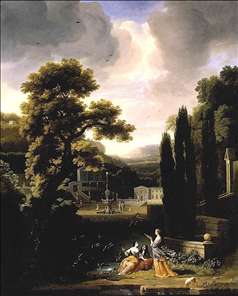Dutch draughtsman and painter. He was referred to as a painter on the occasion of his (late) marriage on 11 April 1668, but in the will drawn up after the death of his wife in 1677 he is called a merchant . He did indeed trade in silks and velvets. As an artist, he was self-taught and should probably be considered an amateur. His textile business occasioned visits, among other places, to Italy, France, England and Scotland, where he made accomplished landscape drawings. Panoramic views of English towns (Chatham, Greenwich, London, Rochester and Rye) dating from the 1660s were later included in the Atlas van der Hem (Vienna, sterreich).
In 1663 he journeyed along the Rhine with Gerbrand
van den Eeckhout and Jan
Lievens, as is evident from the many drawings by all three artists of the same locations, including Rhenen, Arnhem and Cleve (e.g. Amsterdam, Rijksmuseum; Edinburgh, National Gallery of Scotland; Haarlem, Teylers Museum; St Petersburg, Hermitage). Besides these topographical views, Esselens also drew imaginary landscapes, for example of riverbanks and coastlines with fishermen or tradesmen in the manner of Simon de
Vlieger, woody landscapes suggesting the influence of Anthoni Waterlo and hilly landscapes in the style of his travelling companions
van den Eeckhout and Lievens. Some works seem to have been inspired by etchings and drawings of the Dutch countryside made by
Rembrandt in the 1640s and 1650s. It would, however, be an exaggeration to consider Esselens a pupil of Rembrandt, as has often been suggested since the 19th century. Despite a clearly recognizable personal style of drawing, Esselens was often inspired by the work of other draughtsmen. This is also true of his paintings, which are somewhat eclectic in nature but sometimes of a surprisingly high artistic standard. His seaside views (e.g. Amsterdam, Rijksmuseum; Copenhagen, Statens Museum for Kunst), with their characteristic atmosphere, betray the influence of Adriaen van de Velde, but the use of silver-grey tints also suggests that of Simon de Vlieger.
He painted Arcadian landscapes, in a rather uninspired style, that are reminiscent of Cornelis van
Poelenburgh (e.g. Brunswick, Herzog Anton-Ulrich-Museum), but he also occasionally produced charming landscapes bathed in southern light, for instance the Landscape with Hunters (Amsterdam, Rijksmuseum) and the Scottish Landscape (The Hague, Museum Bredius). In his non-topographical landscapes, animals and, especially, figures play an important role: fishermen or townspeople are seen buying fish in his beach views, while in other works elegantly dressed ladies and gentlemen are involved in recreational pursuits (e.g. Elegant Hunting Party on the Bank of a River; Rotterdam, Museum Boijmans Van Beuningen). He died a wealthy man; his friend and fellow silk merchant Abraham Rutgers (1632-1699), who was also an avid amateur draughtsman, was appointed guardian of his children. Rutgers was also the administrator of Esselens s estate, which included many of the latter s drawings, which he repeatedly copied.

